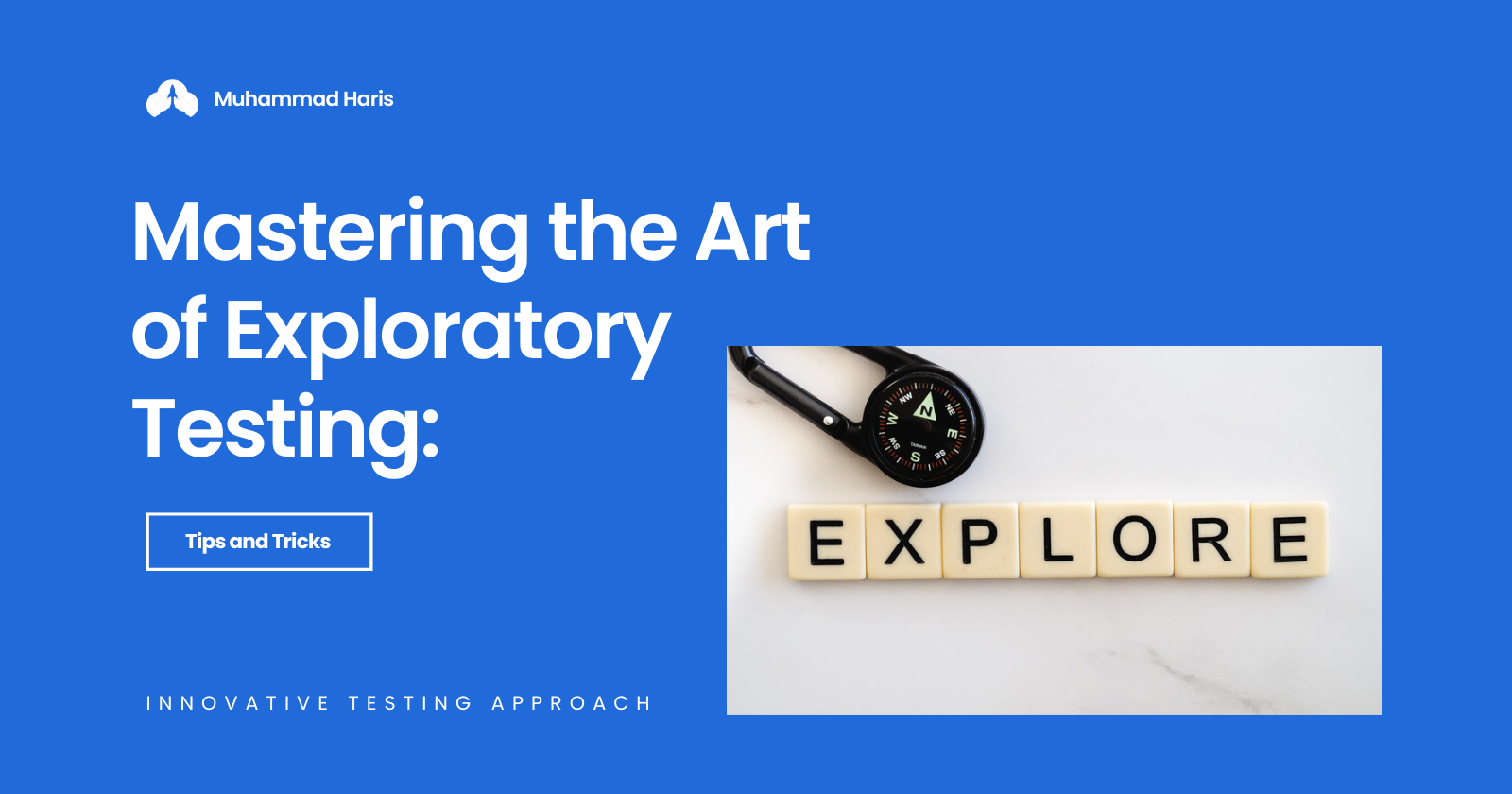Mastering the Art of Exploratory Testing: Tips and Tricks
 Muhammad Haris
Muhammad Haris
Introduction
Exploratory testing is a crucial part of software testing that allows testers to uncover hidden defects and explore the application under test in an unscripted and flexible manner. In this blog post, we will delve into the world of exploratory testing, and understand its core principles, techniques, and strategies. We will also explore the challenges faced during exploratory testing and discuss effective ways to overcome them. By the end of this blog post, you will be equipped with the knowledge and tools necessary to master the art of exploratory testing.
Understanding Exploratory Testing
Exploratory testing is a dynamic and flexible approach to testing where testers actively learn, design, and execute test cases simultaneously. Unlike scripted testing, exploratory testing does not follow a predetermined set of test cases. Instead, it relies on the tester's skills, experience, and creativity to uncover bugs that traditional testing might miss.
Differentiating exploratory testing from other methodologies is key to understanding its value. While scripted testing focuses on executing predefined test cases, exploratory testing adapts and evolves as the tester explores the application. It allows testers to respond dynamically to changing requirements and discover issues in real time. This flexibility and adaptability make exploratory testing a powerful tool in the software testing arsenal.
The benefits of exploratory testing abound. It helps identify defects that scripted testing might overlook, uncovers unique user perspectives, and promotes effective collaboration and communication among team members. By examining the application through the eyes of the end-user, exploratory testing aims to improve the overall quality and user experience of the software.
Preparing for Exploratory Testing
Before jumping into exploratory testing, it is essential to set objectives and goals. Clearly defining what you want to achieve through exploratory testing will help guide your testing efforts and ensure a focused approach. By establishing specific objectives and goals, you can measure the effectiveness of your exploratory testing and track your progress over time.
Understanding the application under test (AUT) is another crucial aspect of preparation. Familiarize yourself with the functionalities, user interfaces, and relevant domain knowledge related to the AUT. This knowledge will enable you to craft effective charters for your exploratory testing sessions.
Defining test charters is a practice that outlines the scope and focus of your exploration. Test charters act as a roadmap, guiding your testing efforts and ensuring structured exploration. By defining clear charters, you can allocate time and resources efficiently, maximizing the value of each exploratory testing session.
Techniques and Strategies
Exploratory testing encompasses various techniques and strategies that enhance the effectiveness of your testing efforts. Let's explore some of these techniques:
Ad-hoc testing: This technique involves testing without any predefined plan or structure. Ad-hoc testing allows testers to explore the application based on their intuition and observations. It is particularly useful for quick bug identification and uncovering unexpected issues.
Scenario-based testing: In this technique, testers create and execute test scenarios that simulate real-life user interactions. By testing how the software performs in different usage scenarios, testers can gain valuable insights into its behavior and uncover potential defects.
Risk-based testing: Risk-based testing focuses on identifying and addressing the most critical and high-risk areas of the application. By prioritizing testing efforts based on the potential impact and likelihood of failure, testers can effectively optimize their exploratory testing sessions.
Session-based testing: Session-based testing involves conducting testing in predefined time-boxed sessions. Testers set specific objectives for each session and document their findings systematically. This approach allows for focused and structured exploration, ensuring maximum coverage within a given timeframe.
Pair testing: Pair testing involves two testers working together to explore the application. This collaborative approach fosters knowledge sharing, improves test coverage, and increases the likelihood of identifying defects. Pair testing can be particularly beneficial when exploring complex or critical areas of the software.
Execution and Reporting
Conducting exploratory sessions requires a structured and systematic approach. When executing exploratory testing, it is essential to create a conducive environment that encourages exploration and provides the necessary resources. This includes access to test environments, relevant documentation, and any tools or technologies required for testing.
During exploratory sessions, documenting findings is vital. As exploratory testing is inherently unscripted, capturing the discovered defects, observations, and potential areas of improvement is crucial for future analysis and reference. Effective documentation can help in reproducing discovered defects and facilitates the communication of findings to stakeholders.
Communicating test results effectively is crucial to ensure that the discoveries made during exploratory testing are understood by the relevant stakeholders. Utilize clear and concise language, providing supporting evidence and suggestions for improvement where necessary. Visual aids such as screenshots or screen recordings can also enhance the understanding and impact of the findings.
Overcoming Challenges
While exploratory testing is a valuable testing approach, it does come with its fair share of challenges. Time constraints often pose a significant challenge, as exploratory testing can require more effort and time compared to scripted testing. To overcome this challenge, prioritize critical areas and allocate time accordingly. Breaking down testing into smaller, manageable sessions can also help navigate time constraints effectively.
The lack of documentation is another common challenge faced in exploratory testing. As this approach promotes flexibility and freedom, extensive documentation may not be a priority. However, striking a balance between exploratory instincts and the need for documentation is crucial. Develop lightweight documentation practices that capture important insights and findings without hindering the exploration process.
Balancing between exploration and coverage is a continual challenge when it comes to exploratory testing. With the freedom to explore, testers may focus more on certain areas while unintentionally neglecting others. To address this challenge, define clear test charters and objectives, ensuring that your exploratory testing efforts are well-directed and cover a wide range of functionalities and use cases.
Tools for Exploratory Testing
Exploratory testing can be further enhanced with the help of various tools that facilitate the exploration process. Some tools specifically designed for exploratory testing include tools for session management, session notes, and session reporting. These tools provide a centralized platform to capture, organize, and analyze exploratory testing sessions, making the process more efficient and effective.
Additionally, supportive tools for documentation and tracking play a crucial role in exploratory testing. Tools such as bug tracking systems, test management tools, and screen capture software can aid in documenting and tracking the defects and observations discovered during exploratory testing.
Continuous Improvement
Exploratory testing is a continuous learning process that thrives on improvement. Learning from previous exploratory testing sessions is essential for professional growth and refining testing techniques. Analyze past sessions, evaluate your approaches, and identify areas for improvement. This learning process will empower you to enhance your exploratory testing skills and become more proficient over time.
Incorporating feedback from other team members and stakeholders is another valuable way to enhance your exploratory testing practices. Seek input and perspective from different sources, be open to suggestions, and actively engage in discussions. By embracing feedback, you can broaden your approach and gain valuable insights from others' experiences.
Keeping up with industry trends and advancements in the field of exploratory testing is essential for staying relevant and maximizing the benefits of this approach. Stay connected with the testing community, attend conferences and webinars, and explore new tools and techniques. By continuously learning and adapting to evolving practices, you can ensure that your exploratory testing remains effective and aligned with industry standards.
Case Studies and Examples
To further illustrate the power and effectiveness of exploratory testing, let's explore some real-world examples. These examples highlight successful exploratory testing experiences and the valuable lessons learned from failures. By analyzing these case studies, we can gain practical insights and inspiration for our exploratory testing journey.
Conclusion
Mastering the art of exploratory testing requires a combination of skills, strategies, and continuous improvement. It is a dynamic and valuable testing approach that uncovers hidden defects, promotes collaboration, and enhances software quality. By embracing exploratory testing, you can provide valuable insights into the application under test, ensuring its overall integrity, and delivering a superior user experience. So, embrace the art of exploratory testing, and let your testing efforts reach new heights!
Subscribe to my newsletter
Read articles from Muhammad Haris directly inside your inbox. Subscribe to the newsletter, and don't miss out.
Written by

Muhammad Haris
Muhammad Haris
Hello People 👋, Muhammad Haris here! I am an SQA, Automation Engineer, Python / Web Developer, Project Manager, Content Creator, Open Source Contributor & Tech Enthusiast. I love managing Projects, Events, and Programs.